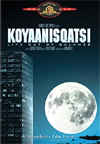Koyaanisqatsi
At times beautifully horrific and horribly beautiful, Godfrey Reggio’s 1983 visual fantasia ’Koyaanisqatsi’ transformed clouds into raging rivers, skyscrapers into lunar altars and rush-hour humanity into sausage links. MGM Home Entertainment’s new DVD not only faithfully replicates Reggio’s dangerous visions, but also forces new thought as to how the world has changed since its first release.
Translated from the Hopi language as ’life out of balance,’ ’Koyaanisqatsi’ took viewers on a journey through an America no one had ever seen before. For 87 minutes, Reggio, aided by cinematographer Ron Fricke and composer Philip Glass, looked at the then-contemporary landscape and saw that the nuts and bolts of everyday life were slowly replacing our organic past with a mechanized present and, possibly, future. Yet, the film makes some of these frightening thoughts so beautiful-looking that you wonder where Reggio’s allegiances lie – man or machine? This film also introduced filmgoers to the minimalist music of Glass. His first film score is a perfect accompaniment to the images: mechanization relies on repetition and Glass’ score finds music in that ’monotony,’ as surely as Reggio finds poetry in a waitress’ frozen smiling face or a plane lumbering on a runway.
The 1.85:1 anamorphic widescreen transfer represents the first widescreen presentation of the title on home video. The picture looks sharp with solid but not brilliant colors. Details are nicely defined, but just shy of that three-dimensional quality from the best transfers. This may sound like something out of Glass’ score but I feel I keep repeating myself when I say that I detected no digital or compression artifacts.
Originally released theatrically in Dolby Stereo, the DVD sports a brand-new 5.1 surround remix. The new soundtrack is well balanced and pleasing. Since the soundtrack is composed mainly of Glass’ score and a smattering of sound effects (street noises, machinery), the directionality of the new soundtrack is confined mostly to the widening of the front soundstage and music fill in the surrounds.
(This is purely an objective note, but the sound is so good that I found myself daydreaming, the music is so hypnotic.)
The extras consist mainly of the theatrical trailers for the ’Qatsi’ Trilogy: ’Koyaanisqatsi,’ ’Powaqqatsi’ (also recently released on DVD by MGM) and the upcoming theatrical release of the concluding title ’Naqoyqatsi.’ The trailers are presented in anamorphic widescreen with matrixed surround sound. For such challenging and non-traditional subject matters, the montage-style editing of the trailers perfectly captures the spirit and intent of the films. New interviews with director Reggio and composer Glass are featured in the documentary ’Essence of Life.’ Running almost 30 minutes, their reminiscences are very erudite, touching not only on the challenges of filming and composing, but how the film’s life over the years has affected them from a philosophical perspective. My only nudge on this is that Fricke, extolled at length at Reggio, is not represented in the documentary.

